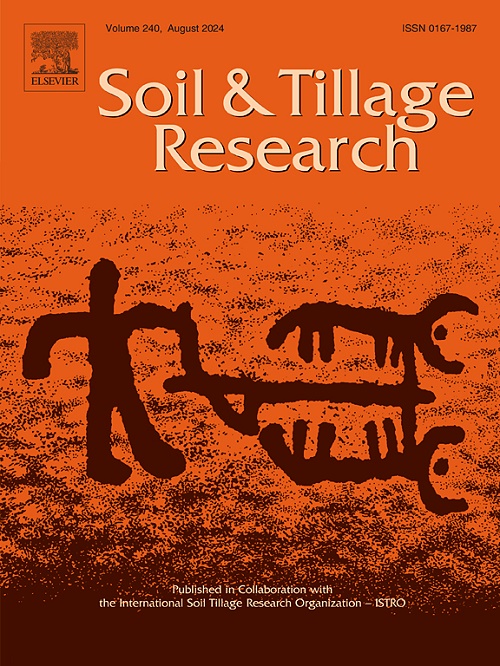Experimental study on splash erosion resistance of granite residual soil improved by microbially induced carbonate precipitation
IF 6.1
1区 农林科学
Q1 SOIL SCIENCE
引用次数: 0
Abstract
Granite residual soil (GRS) splash erosion poses a global ecological challenge by destroying the soil structure and accelerating the subsequent erosion. Although the microbially induced carbonate precipitation (MICP) technology has demonstrated the potential ability in soil erosion control, its impact on the splash erosion resistance performance of GRS, particularly the regulatory role of bacterial concentration, remains insufficiently studied. This study addressed the effect of bacterial solution concentration (OD600=0.5, 0.75, 1.0) on the splash erosion resistance of GRS treated by MICP, through penetration tests, rainfall splash erosion tests, and scanning microscope tests. Results demonstrated that MICP treatment significantly improves the splash erosion resistance capacity of GRS. Optimal bacterial solution concentration was at OD600= 0.75, reducing soil erosion weight by 70.04 %-78.00 % and increasing surface strength by 288 %-513 %. This concentration facilitated the formation of a mechanically stable calcite network, enabling deep mineralization and establishing a gradient-reinforced structure. Conversely, a higher concentration (OD600=1.0) induced pore clogging and generated metastable vaterite aggregates, while a lower concentration (OD600=0.5) weakened cementation due to insufficient CaCO3 precipitation. These findings underscore the critical role of bacterial concentration in determining spatial uniformity, crystal morphology, and CaCO3 content, which collectively govern the effectiveness of the hard crust layers in resisting splash erosion. It was also found that the hydrophobic hard crust layers were generated via pore filling and particle cementation, which dissipates raindrop kinetic energy and protects the uncemented layer. These findings provide direct theoretical and technical guidance for field applications in GRS regions.
微生物诱导碳酸盐降水改善花岗岩残积土抗溅蚀性的试验研究
花岗岩残积土(GRS)溅蚀破坏了土壤结构,加速了后续侵蚀,对全球生态构成了挑战。虽然微生物诱导碳酸盐降水(MICP)技术在控制土壤侵蚀方面具有潜在的能力,但其对GRS抗溅蚀性能的影响,特别是细菌浓度的调节作用仍未得到充分研究。本研究通过渗透试验、降雨溅蚀试验和扫描显微镜试验,研究了细菌溶液浓度(OD600=0.5、0.75、1.0)对MICP处理的GRS抗溅蚀性能的影响。结果表明,MICP处理显著提高了GRS抗溅蚀能力。最优菌液浓度为OD600= 0.75时,土壤侵蚀重降低70.04 % ~ 78.00 %,表面强度提高288 % ~ 513 %。这种富集有利于形成机械稳定的方解石网络,有利于深部矿化,形成梯度强化结构。相反,较高的浓度(OD600=1.0)会导致孔隙堵塞,形成亚稳的水晶石聚集体,而较低的浓度(OD600=0.5)由于CaCO3沉淀不足,会削弱胶结作用。这些发现强调了细菌浓度在决定空间均匀性、晶体形态和CaCO3含量方面的关键作用,这些因素共同决定了硬壳层抵抗飞溅侵蚀的有效性。疏水硬壳层是通过孔隙填充和颗粒胶结形成的,耗散雨滴动能,保护未胶结层。这些研究结果为GRS区域的野外应用提供了直接的理论和技术指导。
本文章由计算机程序翻译,如有差异,请以英文原文为准。
求助全文
约1分钟内获得全文
求助全文
来源期刊

Soil & Tillage Research
农林科学-土壤科学
CiteScore
13.00
自引率
6.20%
发文量
266
审稿时长
5 months
期刊介绍:
Soil & Tillage Research examines the physical, chemical and biological changes in the soil caused by tillage and field traffic. Manuscripts will be considered on aspects of soil science, physics, technology, mechanization and applied engineering for a sustainable balance among productivity, environmental quality and profitability. The following are examples of suitable topics within the scope of the journal of Soil and Tillage Research:
The agricultural and biosystems engineering associated with tillage (including no-tillage, reduced-tillage and direct drilling), irrigation and drainage, crops and crop rotations, fertilization, rehabilitation of mine spoils and processes used to modify soils. Soil change effects on establishment and yield of crops, growth of plants and roots, structure and erosion of soil, cycling of carbon and nutrients, greenhouse gas emissions, leaching, runoff and other processes that affect environmental quality. Characterization or modeling of tillage and field traffic responses, soil, climate, or topographic effects, soil deformation processes, tillage tools, traction devices, energy requirements, economics, surface and subsurface water quality effects, tillage effects on weed, pest and disease control, and their interactions.
 求助内容:
求助内容: 应助结果提醒方式:
应助结果提醒方式:


